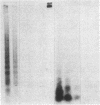Abstract
A Lyt-2+, trinitrophenyl-specific, lymphotoxin-secreting, cytotoxic T-cell line, PCl 55, mediates the digestion of target cell DNA into discretely sized fragments. This phenomenon manifests itself within 30 min after effector cell encounter as measured by the release of 3H counts from target cells prelabeled with [3H]deoxythymidine and occurs even at very low effector to target cell ratios (0.25:1). A Lyt-1+, ovalbumin-specific, lymphotoxin-secreting T-helper cell clone, 5.9.24, is also able to mediate fragmentation of target cell DNA over a time course essentially indistinguishable from the cytotoxic T lymphocyte-mediated hit. Cell-free lymphotoxin-containing supernatants also cause release of DNA from targets, although they require a longer time course, on the order of 24 hr. In contrast, lysis of cells by antibody plus complement or Triton X-100 does not result in DNA release even after extended periods of incubation (24 hr). All three treatments that result in the release of DNA from cells cause fragmentation of that DNA into discretely sized pieces that are multiples of 200 base pairs. The results thus suggest that cytotoxic T cells, lymphotoxin-secreting helper clones with cytolytic activity, and lymphotoxin all effect target cell destruction by means of a similar mechanism and that observed differences in time course and the absence of target cell specificity in killing mediated by lymphotoxin may simply reflect differences in the mode of toxin delivery.
Full text
PDF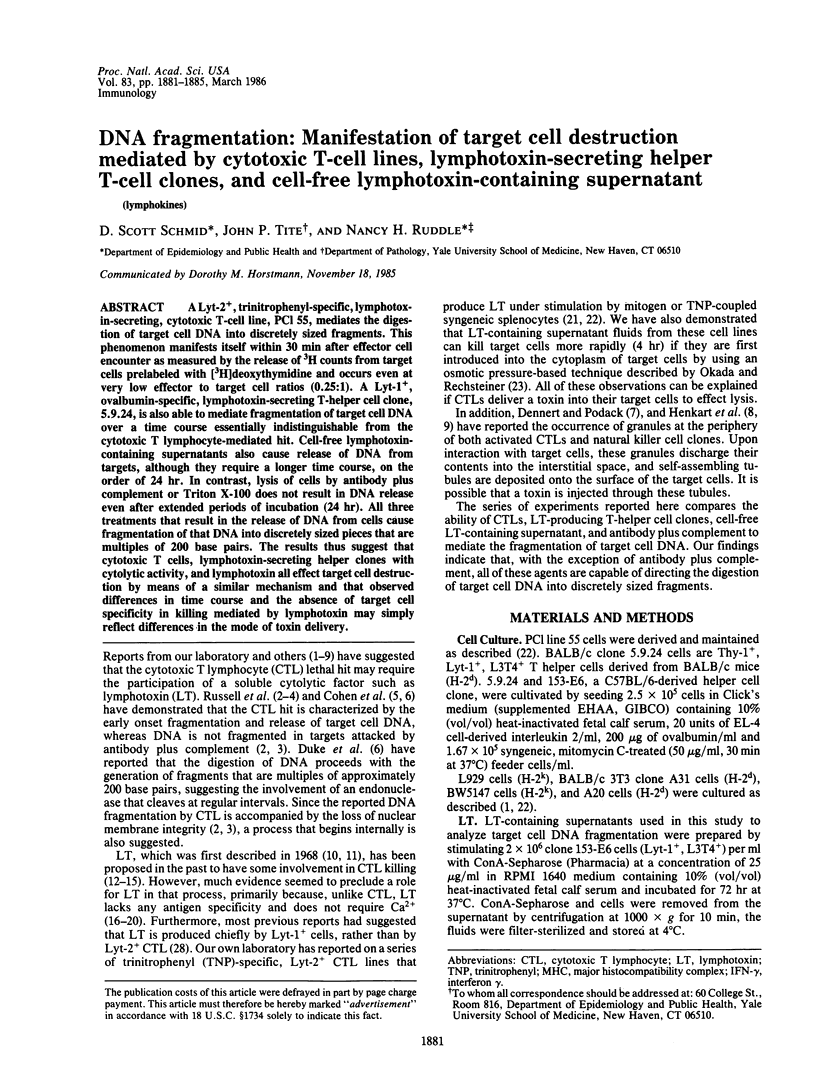
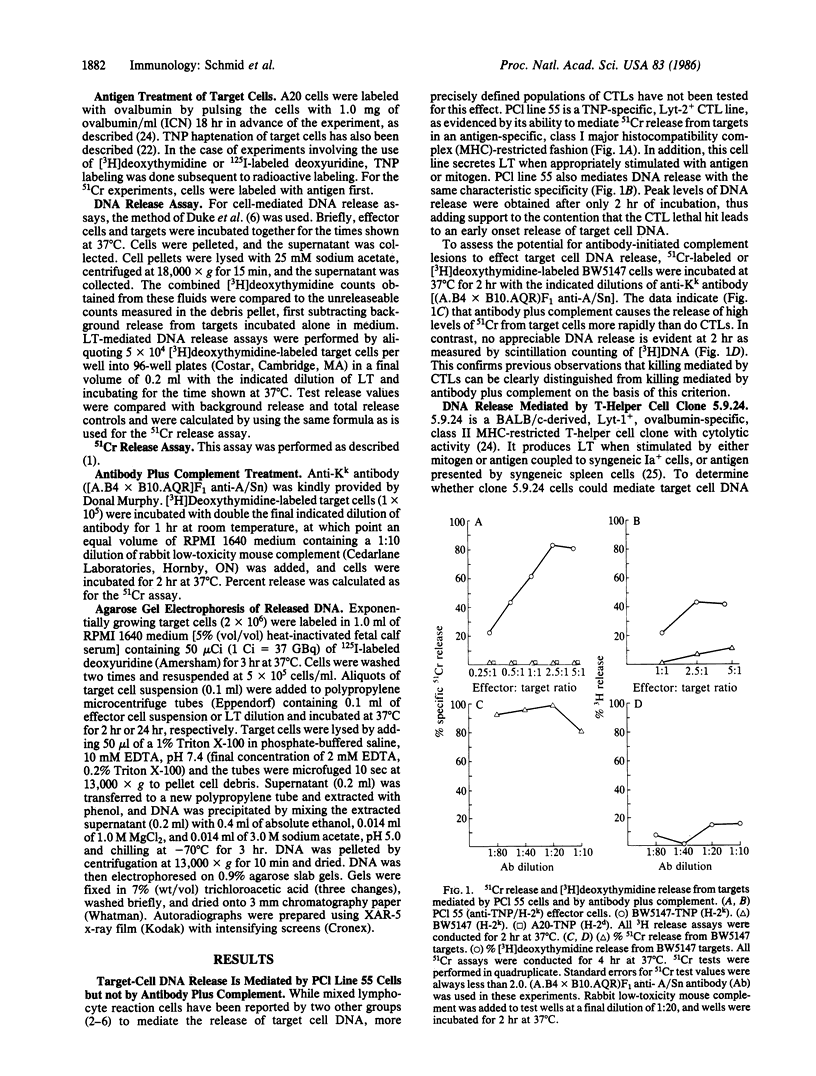
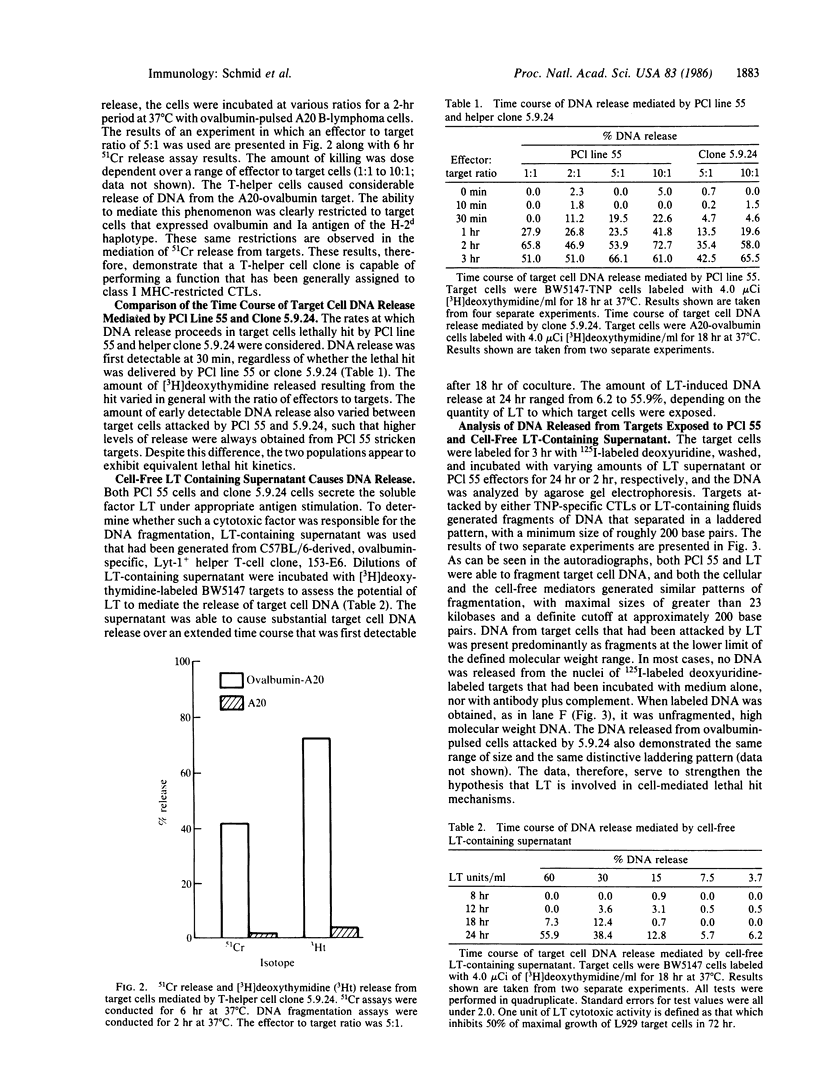
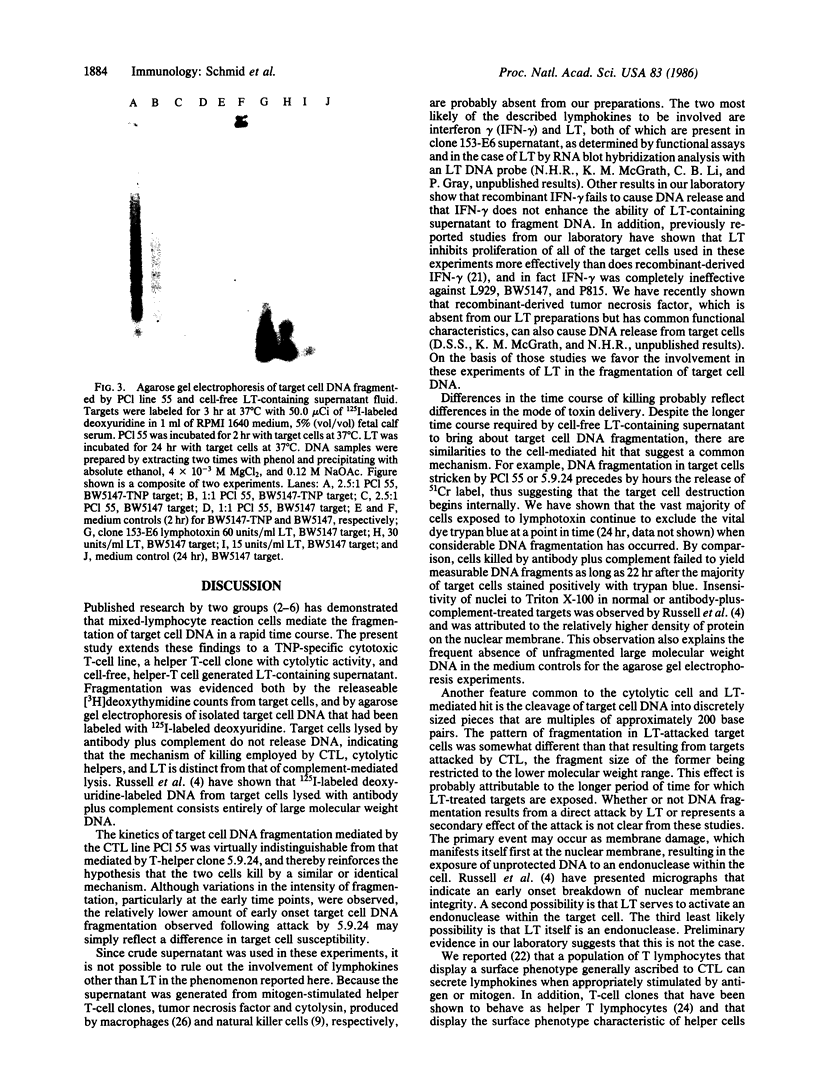
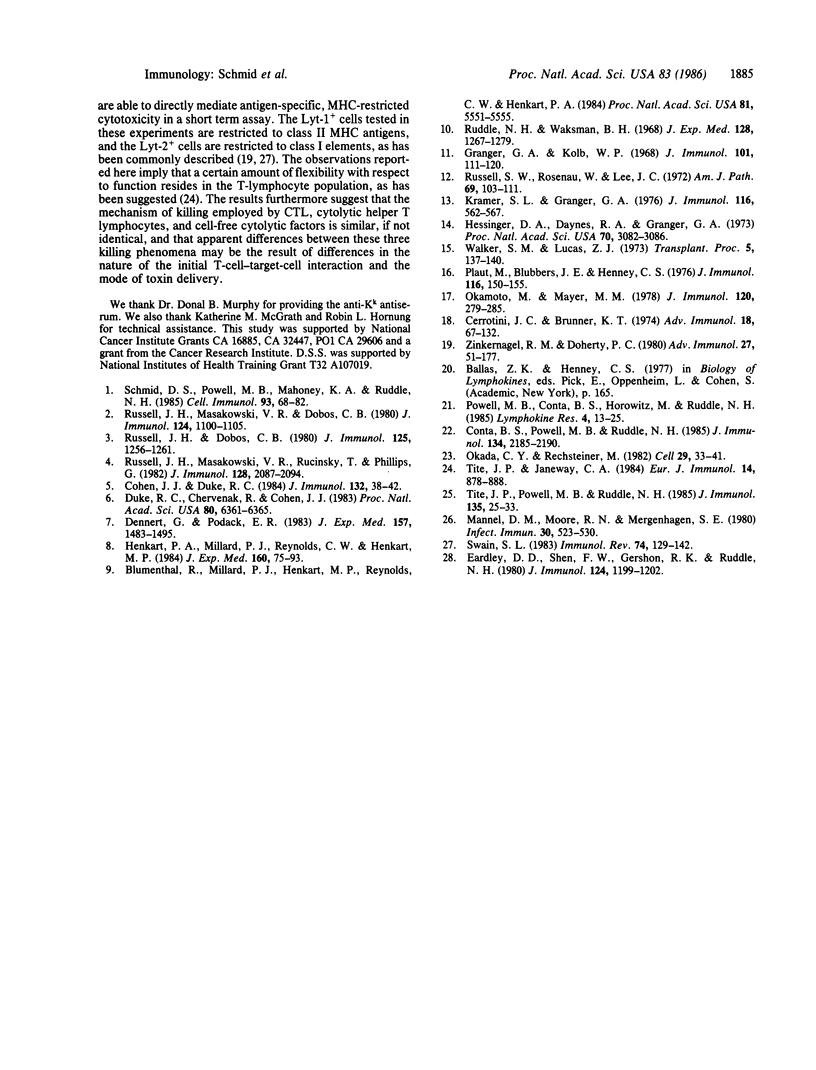
Images in this article
Selected References
These references are in PubMed. This may not be the complete list of references from this article.
- Blumenthal R., Millard P. J., Henkart M. P., Reynolds C. W., Henkart P. A. Liposomes as targets for granule cytolysin from cytotoxic large granular lymphocyte tumors. Proc Natl Acad Sci U S A. 1984 Sep;81(17):5551–5555. doi: 10.1073/pnas.81.17.5551. [DOI] [PMC free article] [PubMed] [Google Scholar]
- Cerottini J. C., Brunner K. T. Cell-mediated cytotoxicity, allograft rejection, and tumor immunity. Adv Immunol. 1974;18:67–132. doi: 10.1016/s0065-2776(08)60308-9. [DOI] [PubMed] [Google Scholar]
- Cohen J. J., Duke R. C. Glucocorticoid activation of a calcium-dependent endonuclease in thymocyte nuclei leads to cell death. J Immunol. 1984 Jan;132(1):38–42. [PubMed] [Google Scholar]
- Conta B. S., Powell M. B., Ruddle N. H. Activation of Lyt-1+ and Lyt-2+ T cell cloned lines: stimulation of proliferation, lymphokine production, and self-destruction. J Immunol. 1985 Apr;134(4):2185–2190. [PubMed] [Google Scholar]
- Dennert G., Podack E. R. Cytolysis by H-2-specific T killer cells. Assembly of tubular complexes on target membranes. J Exp Med. 1983 May 1;157(5):1483–1495. doi: 10.1084/jem.157.5.1483. [DOI] [PMC free article] [PubMed] [Google Scholar]
- Duke R. C., Chervenak R., Cohen J. J. Endogenous endonuclease-induced DNA fragmentation: an early event in cell-mediated cytolysis. Proc Natl Acad Sci U S A. 1983 Oct;80(20):6361–6365. doi: 10.1073/pnas.80.20.6361. [DOI] [PMC free article] [PubMed] [Google Scholar]
- Eardley D. D., Shen F. W., Gershon R. K., Ruddle N. H. Lymphotoxin production by subsets of T cells. J Immunol. 1980 Mar;124(3):1199–1202. [PubMed] [Google Scholar]
- Granger G. A., Kolb W. P. Lymphocyte in vitro cytotoxicity: mechanisms of immune and non-immune small lymphocyte mediated target L cell destruction. J Immunol. 1968 Jul;101(1):111–120. [PubMed] [Google Scholar]
- Henkart P. A., Millard P. J., Reynolds C. W., Henkart M. P. Cytolytic activity of purified cytoplasmic granules from cytotoxic rat large granular lymphocyte tumors. J Exp Med. 1984 Jul 1;160(1):75–93. doi: 10.1084/jem.160.1.75. [DOI] [PMC free article] [PubMed] [Google Scholar]
- Hessinger D. A., Daynes R. A., Granger G. A. Binding of human lymphotoxin to target-cell membranes and its relation to cell-mediated cytodestruction. Proc Natl Acad Sci U S A. 1973 Nov;70(11):3082–3086. doi: 10.1073/pnas.70.11.3082. [DOI] [PMC free article] [PubMed] [Google Scholar]
- Kramer S. L., Granger G. A. The role of lymphotoxin in target cell destruction induced by mitogen-activated human lymphocytes in vitro. II. The correlation of temperature and trypsin-sensitive phases of lymphotoxin-induced and lymphocyte-mediated cytotoxicity. J Immunol. 1976 Feb;116(2):562–567. [PubMed] [Google Scholar]
- Männel D. N., Moore R. N., Mergenhagen S. E. Macrophages as a source of tumoricidal activity (tumor-necrotizing factor). Infect Immun. 1980 Nov;30(2):523–530. doi: 10.1128/iai.30.2.523-530.1980. [DOI] [PMC free article] [PubMed] [Google Scholar]
- Okada C. Y., Rechsteiner M. Introduction of macromolecules into cultured mammalian cells by osmotic lysis of pinocytic vesicles. Cell. 1982 May;29(1):33–41. doi: 10.1016/0092-8674(82)90087-3. [DOI] [PubMed] [Google Scholar]
- Okamoto M., Mayer M. M. Studies on the mechanism of action of guinea pig lymphotoxin. II. Increase of calcium uptake rate in LT-damaged target cells. J Immunol. 1978 Jan;120(1):279–285. [PubMed] [Google Scholar]
- Plaut M., Bubbers J. E., Henney C. S. Studies of the mechanism of lymphocyte-mediated cytolysis. VII. Two stages in the T cell-mediated lytic cycle with distinct cation requirements. J Immunol. 1976 Jan;116(1):150–155. [PubMed] [Google Scholar]
- Powell M. B., Conta B. S., Horowitz M., Ruddle N. H. The differential inhibitory effect of lymphotoxin and immune interferon on normal and malignant lymphoid cells. Lymphokine Res. 1985 Winter;4(1):13–26. [PubMed] [Google Scholar]
- Ruddle N. H., Waksman B. H. Cytotoxicity mediated by soluble antigen and lymphocytes in delayed hypersensitivity. 3. Analysis of mechanism. J Exp Med. 1968 Dec 1;128(6):1267–1279. doi: 10.1084/jem.128.6.1267. [DOI] [PMC free article] [PubMed] [Google Scholar]
- Russell J. H., Dobos C. B. Mechanisms of immune lysis. II. CTL-induced nuclear disintegration of the target begins within minutes of cell contact. J Immunol. 1980 Sep;125(3):1256–1261. [PubMed] [Google Scholar]
- Russell J. H., Masakowski V. R., Dobos C. B. Mechanisms of immune lysis. I. Physiological distinction between target cell death mediated by cytotoxic T lymphocytes and antibody plus complement. J Immunol. 1980 Mar;124(3):1100–1105. [PubMed] [Google Scholar]
- Russell J. H., Masakowski V., Rucinsky T., Phillips G. Mechanisms of immune lysis. III. Characterization of the nature and kinetics of the cytotoxic T lymphocyte-induced nuclear lesion in the target. J Immunol. 1982 May;128(5):2087–2094. [PubMed] [Google Scholar]
- Russell S. W., Rosenau W., Lee J. C. Cytolysis induced by human lymphotoxin. Am J Pathol. 1972 Oct;69(1):103–118. [PMC free article] [PubMed] [Google Scholar]
- Schmid D. S., Powell M. B., Mahoney K. A., Ruddle N. H. A comparison of lysis mediated by Lyt 2+ TNP-specific cytotoxic-T-lymphocyte (CTL) lines with that mediated by rapidly internalized lymphotoxin-containing supernatant fluids: evidence for a role of soluble mediators in CTL-mediated killing. Cell Immunol. 1985 Jun;93(1):68–82. doi: 10.1016/0008-8749(85)90389-2. [DOI] [PubMed] [Google Scholar]
- Swain S. L. T cell subsets and the recognition of MHC class. Immunol Rev. 1983;74:129–142. doi: 10.1111/j.1600-065x.1983.tb01087.x. [DOI] [PubMed] [Google Scholar]
- Tite J. P., Janeway C. A., Jr Cloned helper T cells can kill B lymphoma cells in the presence of specific antigen: Ia restriction and cognate vs. noncognate interactions in cytolysis. Eur J Immunol. 1984 Oct;14(10):878–886. doi: 10.1002/eji.1830141004. [DOI] [PubMed] [Google Scholar]
- Tite J. P., Powell M. B., Ruddle N. H. Protein-antigen specific Ia-restricted cytolytic T cells: analysis of frequency, target cell susceptibility, and mechanism of cytolysis. J Immunol. 1985 Jul;135(1):25–33. [PubMed] [Google Scholar]
- Walker S. M., Lucas Z. J. Role of soluble cytotoxins in cell-mediated immunity. Transplant Proc. 1973 Mar;5(1):137–140. [PubMed] [Google Scholar]
- Zinkernagel R. M., Doherty P. C. MHC-restricted cytotoxic T cells: studies on the biological role of polymorphic major transplantation antigens determining T-cell restriction-specificity, function, and responsiveness. Adv Immunol. 1979;27:51–177. doi: 10.1016/s0065-2776(08)60262-x. [DOI] [PubMed] [Google Scholar]



